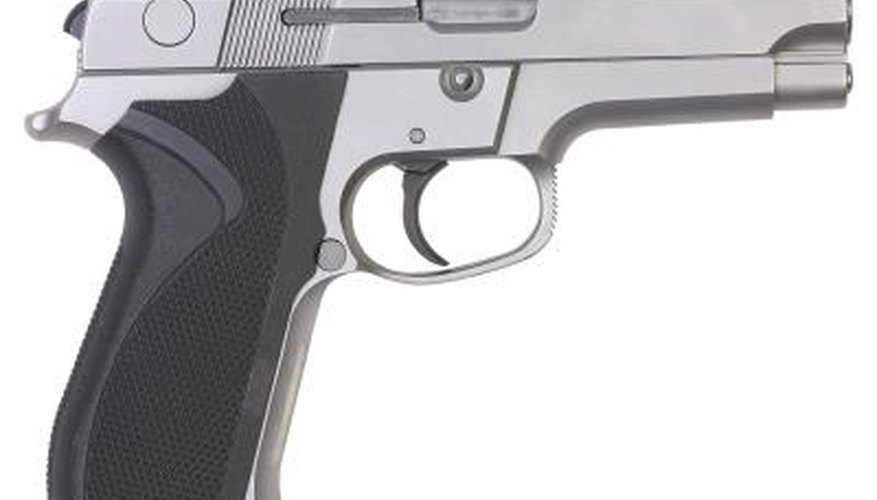
All semi-automatic firearms perform the same three functions after you pull the trigger: the gun fires, the spent cartridge ejects and the next cartridge loads into the chamber. The additional elements of semi-automatic operation differ according to whether the firearm is single-action or double-action. Early semi-automatic pistols such as the Luger and the Colt Model 1911 were entirely single-action. The German Walther, introduced in the late 1920s, was the first double-action model. The Walther was a police model and, in the years since, many officers have used double-action, semi-auto pistols as duty weapons for law enforcement.
Single Action
In a single action semi-automatic pistol, once you insert the magazine and cock the hammer, the action of pulling the trigger performs just one function: releasing the hammer to fire the weapon. Recocking the hammer for the next shot is automatically performed by the operating mechanism. Thus, the pistol is fully ready to fire the next shot with another single-action pull of the trigger to release the hammer. Since the trigger pull performs just a single function, the trigger pull on a single action firearm is light and short.
Double Action
In double-action operation, pulling the trigger performs more than a single function. After the first shot in a double-action only firearm, the mechanism ejects the spent cartridge and chambers the next round, but does not cock the hammer back. The hammer remains in the down position. When the shooter pulls the trigger for the next shot, the trigger mechanism performs the dual action of pushing the hammer back to the cocked position, then releasing it to fire the shot. Because the trigger mechanism performs two functions, the trigger pull on a single-action firearm is long and heavy. Some police model double-action pistols have a 15-pound trigger pull.
Single Action Safety
Since the hammer is cocked when the slide chambers the first round, and again after every shot, loaded single action semi-automatics may be only a short, light trigger pull away from accidental discharge. For safety, either carry the weapon with no round chambered, necessitating operating the slide to make it fire-ready, or it must utilize external safeties for "cocked and locked" carry. Most single-action safeties function by blocking the hammer so it will not fall if the trigger is pulled or by blocking the trigger itself. Alternatively, many have decocking levers to safely lower the hammer from the cocked position for carry, requiring manually recocking to fire.
Double Action Safety
Because double action semi-automatics do not cock the hammer, the weapon is not as prone to inadvertent discharge, so safeties are not as necessary. Many double-action semi-automatics designed for law enforcement or military service employ no external safety. The long, multi-pound trigger pull of the double- action mechanism serves as its primary safety, in addition to internal safeties to guard against accidental discharge if you drop the weapon.
Speed Versus Accuracy
When carried safely, single-action semi-autos require the safety to be disengaged before they can be fired. Since double-action pistols can be carried without an external safety that needs to be disengaged, double- action firearms are considered to be faster on the first shot. On the other hand, the shorter, lighter trigger pull of a single-action mechanism is more conducive to steady aim and accuracy than the long, heavy trigger pull of a double-action. There's a saying: a single-action wins marksmanship trophies but double-action wins gunfights.
References
Writer Bio
Gus Stephens has written about aviation, automotive and home technology for 15 years. His articles have appeared in major print outlets such as "Popular Mechanics" and "Invention & Technology." Along the way, Gus earned a Bachelor of Arts in communications. If it flies, drives or just sits on your desk and blinks, he's probably fixed it.



